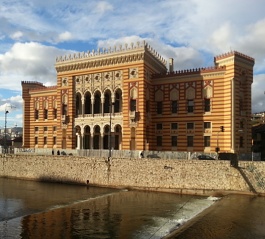
The building of the Sarajevo National Library also carries a Czech trace
 |
- The former city hall, built on the eastern ridge of Sarajevo's historical center, also has a Czech connection. The original design for a representative seat of the city administration was, in fact, created by Karel Pařík, a native of Veliš near Jičín, at the end of the 1880s. However, the proposal of the architect, who shaped several important buildings of modern Sarajevo, was rejected by the highest representative of the Austrian government for Bosnia, Benjamin Kállay.
- Nevertheless, the triangular ground plan of Pařík's design remained, on which the architect (and excellent chess player) Alexander Wittek designed the building in a unique Moorish style. He was particularly inspired by the famous Cairo mosque of Kemal II and visited the Egyptian metropolis several times for that reason. However, Wittek also did not manage to complete the building, as he committed suicide in 1894. His project was brought to completion by architect Ćiril Iveković.
- The city administration moved into the city hall, which impresses passersby at first glance with its majesty—especially compared to the original low buildings of Sarajevo—and its vivid colors, in April 1896. The building served officials for more than half a century; besides the mayor and councilors, it was also used by the district court and the Bosnian parliament. In 1947, the building was transformed into a library, first a city library, later hosting the National and University Library of Bosnia and Herzegovina.
- Images of the building circulated the world for the first time as early as the beginning of the 20th century. It was the Sarajevo city hall where Archduke Franz Ferdinand d'Este arrived on June 28, 1914, at half past ten in the morning after the first failed assassination attempt, to properly reprimand the present dignitaries. "Mr. Mayor, I came on a visit and was welcomed with bombs. This crosses all limits," fumed the heir to the Austrian throne. He then listened to a prepared speech and left the city hall to meet his death at the hands of Gavrilo Princip.
- For the second time, now as a library, the building drew attention during the civil war in Bosnia and Herzegovina, which began in the spring of 1992. The Sarajevo National Library became one of the targets of artillery bombardment. The fateful night was from August 25 to 26, 1992, when a fire engulfed the building. Despite the courage of Sarajevo residents, who tried to save its collections from the burning library despite the danger, the entire library catalog and about 80 percent of its holdings, including rare documents, were destroyed.
- After the fire, practically only the outer walls remained standing; all ceilings collapsed, and a layer of rubble more than a meter thick remained on the ground floor. In these ruins, cellist Vedran Smajlović, dressed in a tuxedo, played Adagio in G minor by the Italian composer Tomaso Albinoni in September 1992, and the musician's photographs were published by almost all major world media. The melancholic piece became one of the symbols of the Siege of Sarajevo.
- The restoration of the damaged library began only a few months after the peace agreement was signed in Dayton, Ohio, in November 1995, but the work lasted a long 18 years. Similar to the case of the Old Bridge in the Herzegovinian town of Mostar, funds for the reconstruction flowed in from many countries, with the library's roof being repaired first, thanks to Austrian funds (1997). The last, fourth phase, focused on restoring the facade and architectural details and the interior furnishings, began two years ago. The total cost of the restoration of the building amounted to approximately ten million euros (270 million crowns).
The English translation is powered by AI tool. Switch to Czech to view the original text source.
0 comments
add comment










